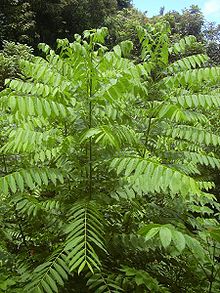Cedrela_odorata
Cedrela odorata
Species of flowering plant in the chinaberry family Meliaceae
Cedrela odorata, commonly known as Spanish cedar, Cuban cedar, or cedro in Spanish,[3] is a commercially important species of tree in the chinaberry family, Meliaceae native to the Neotropics.
This article needs additional citations for verification. (December 2012) |
| Cedrela odorata | |
|---|---|
 | |
| Scientific classification | |
| Kingdom: | Plantae |
| Clade: | Tracheophytes |
| Clade: | Angiosperms |
| Clade: | Eudicots |
| Clade: | Rosids |
| Order: | Sapindales |
| Family: | Meliaceae |
| Genus: | Cedrela |
| Species: | C. odorata |
| Binomial name | |
| Cedrela odorata | |
| Synonyms[2] | |
|
List
| |
This section needs additional citations for verification. (March 2017) |
The genus Cedrela has undergone two major systematic revisions since 1960. The most recent revision reduced the number of species in the genus to seven (Styles, 1981). Cedrela odorata L., contains 28 other synonyms, including C. mexicana M. J. Roem. The taxon "C. angustifolia," a very vigorous type now in demand because of its apparent resistance to the shootborer, was left in an indeterminate status due to insufficient herbarium material. The result is that C. odorata as now constituted is a species showing a high degree of population variation.
Cedro is a tree of the New World tropics, appearing in forests of moist and seasonally dry subtropical or tropical biomes (24) from latitude 26°N on the Pacific coast of Mexico, throughout Central America and the Caribbean, to the lowlands and foothills of most of South America up to 1,200 metres (3,900 ft) altitude, finding its southern limit at about latitude 28°S in Argentina. It has become a troublesome invasive species in the Galapagos Islands[4] where it forms a barrier to the migration of tortoises.[5] Cedro is always found naturally on well-drained soils, often but not exclusively on limestone; it tolerates a long dry season but does not flourish in areas of rainfall greater than about 3,000 millimetres (120 in) or on sites with heavy or waterlogged soils. Individual trees are generally scattered in mixed semi-evergreen or semi-deciduous forests dominated by other species. Mahogany (Swietenia sp.), a close relative, is often found with cedro and both suffer damage from the same pest, the mahogany shootborer (Hypsipyla grandella).
The tree is monoecious semi-deciduous ranging in height from 10 to 30 m (33 to 98 ft). The trunk has a thick grey–brown bark, with longitudinal irregular grain. Pinnately compound leaves, grouped towards the end of the branches, 15–50 cm (5.9–19.7 in) long, with pairs of scythe-shaped leaflets, lanceolate to oblong, 7–15 cm (2.8–5.9 in) × 3–5 cm (1.2–2.0 in) with the base obliquely truncated and asymmetric.
Cedrela odorata is the most commercially important and widely distributed species in the genus Cedrela. Known as Spanish cedar in English commerce, the aromatic wood is in high demand in the American tropics because it is naturally termite- and rot-resistant. An attractive, moderately lightweight wood (specific gravity 0.4), its primary use is in household articles used to store clothing. Cedro heartwood contains an aromatic and insect-repelling resin that is the source of its popular name, Spanish-cedar (it resembles the aroma of the unrelated true cedars (Cedrus spp.) Cedro works easily and makes excellent plywood and veneer and would be more widely used if it could be successfully plantation grown. This plant is often used for honey production (beekeeping) and humidor construction. It is occasionally used for tops or veneers on some kinds of electric guitars. The wood is the traditional choice for making the neck of flamenco and classical guitars.[6]
- Mark, J.; Rivers, M.C. (2017). "Cedrela odorata". IUCN Red List of Threatened Species. 2017: e.T32292A68080590. doi:10.2305/IUCN.UK.2017-3.RLTS.T32292A68080590.en. Retrieved 19 November 2021.
- "The Plant List: Cedrela odorata L." Royal Botanic Gardens, Kew and Missouri Botanic Garden.
- "Forest of daisy trees in Santa Cruz | Wondermondo". 11 March 2012.
- Yirka, Bob; Phys.org. "Galápagos giant tortoises study suggests they may be in danger due to invasive Cedrela odorata trees". phys.org. Retrieved 2024-03-25.
- Romanillos, J.L. (2014) Making A Spanish Guitar
 Data related to Cedrela odorata at Wikispecies
Data related to Cedrela odorata at Wikispecies- Cedro Hembra, Spanish-Cedar
- Overview of Cedrela odorata Archived 2014-11-12 at the Wayback Machine
